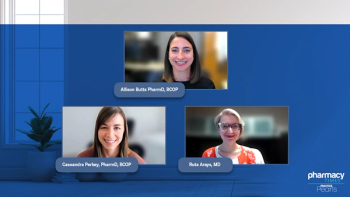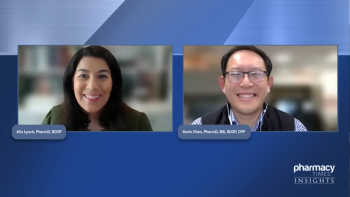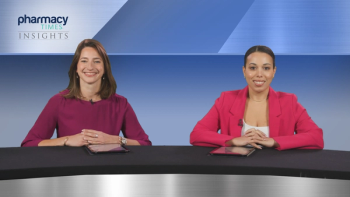
Developing Clinical Pathways for Multiple Myeloma
Key opinion leaders emphasize the critical role of effective clinical pathways for treatment in multiple myeloma.
Episodes in this series

Ryan Haumschild, PharmD, MS, MBA: How are clinical pathways, order sets, and sequencing developed and utilized for patients with multiple myeloma at your facility? When they’re in therapy, are anti-CD38 agents utilized within these treatment regimens? Lastly, have your clinical pathways ever conflicted with payer-mandated pathways? If so, how do you mitigate that to proceed with treatment?
Kathryn Tyler Maples, PharmD, BCOP: That’s an very excellent question. Clinical pathways are very challenging in multiple myeloma. Mr Hanna said it best: you could put the guidelines up and just throw a dart at a dart board, and you’re going to find a regimen that you can use. It’s very challenging in the myeloma world to create a nice, pretty clinical pathway that you can fit every patient into. In my practice, we don’t have a strict clinical pathway that fits every single patient with myeloma. But we try to have a general guidance of pathway. We do this by having the entire multiple myeloma working group come together. We often reconvene after big meetings—ASH [American Society of Hematology] Annual Meeting, ASCO [American Society of Clinical Oncology] Annual Meeting, the IMWG [International Myeloma Working Group] meeting—and discuss how new data are going to impact our practice and if we want to make any changes.
We have a generalized guideline for newly diagnosed myeloma, and it’s pretty easy to come to a consensus. We have our transplant-eligible and transplant-ineligible buckets. Within those buckets we have a standard-risk and a high-risk approach. We can do that, and we have anti-CD38s incorporated in the frontline setting at my institution for patients with newly diagnosed myeloma. It gets a little messier in the relapsed/refractory stage. There’s not a set clinical pathway when we reach that point of the disease. There are preferred and favored regimens, and there’s a generalized path that we tend to follow, but it’s not set in a firm clinical pathway. In terms of how it can flex with payer pathways, this has most commonly come up when using daratumumab in the frontline setting with VRd [bortezomib, lenalidomide, dexamethasone]. Is the addition of daratumumab worth the added cost?
We tried to highlight some of the things we’ve already talked about. We’ve seen the increase in the depth of response and how that should translate into better outcomes for the patient. We will try to do either a peer-to-peer insurance or an appeal if we feel very strongly that this is in the best interest of the patient. We’re not continuing the anti-CD38 most often in the maintenance setting, so that’s 1 other thing we can talk with payers about, that this is going to be an acute phase of using the quad-based regimen. But you have to think about it when building these regimens and pathways, making sure you’re keeping the patient at the center of the conversation but also being mindful of the economic burden.
Ryan Haumschild, PharmD, MS, MBA: What a great overview. As you said, trying to put multiple myeloma as a whole into 1 strict pathway is definitely going to be difficult. But having that framework for success that can help drive most appropriate treatments is important as we try to find the best practices and share that data with our clinicians while they’re treating these patients.
Mr Hanna, how are clinical pathways, formulary navigators, or any clinical decision-support tools being used by your practice to support selection of these high-valued therapies for multiple myeloma? If you have these tools, how are you utilizing them and applying them to anti-CD38 therapies and relapsed/refractory multiple myeloma?
Kirollos S. Hanna, PharmD, BCPS, BCOP: We’re very similar to what Ms Maples is doing at her institution. As Mr Amir Ali said, myeloma has had some of the most approvals that we’ve seen in the past several years. Having recognized that, and all the updates that are coming with or without FDA approval, we have a myeloma working group that meets on a monthly basis. We’re not waiting for any updates or anything like that. We’re just meeting to evaluate operations and new data of multiple myeloma. We have pathways internally that are built. It’s a third-party vendor, solely updated through the NCCN [National Comprehensive Cancer Network] recommendations.
But I’d like to take a moment and echo what Ms Maples said, and what you mentioned, Mr Haumschild, which is that it’s extremely difficult in myeloma. Although this is an area where pathways can significantly help us, there are so much data that we have to incorporate in there. This is a callout for all the pathway vendors to help us get there. You know what I mean? There’s a lot of room for improvement within pathways. We do have them. We don’t dictate or mandate them. Any time we see payer restrictions, we try as anybody would: peer-to-peer insurances, letters for medical necessity. We’re not getting a lot of pushback in the Midwest incorporating CD38 agents in the frontline setting.
Similar to Ms Maples, we’re not doing a lot of maintenance therapy. Since the data have been out, I’ve seen only 2 or 3 patients on a maintenance anti-CD38 agent. As an institution, we’ve done things that shorten chair time, as Ms Maples said. We try to do rapid infusion. Those were some economical things. We’ve definitely switched to generics when they’re available from reliable supply chains. That’s another important thing you have to consider: you don’t want to bounce between different generics if there isn’t a reliable source of that product coming in. That can create some barriers with the drug shortage. Pathways have great opportunity in the grand scheme of things. We’re certainly not there, whether we’re talking about CD38 agents, high-risk patients, or across all of myeloma.
Transcript edited for clarity.
Newsletter
Stay informed on drug updates, treatment guidelines, and pharmacy practice trends—subscribe to Pharmacy Times for weekly clinical insights.












































































































































































































